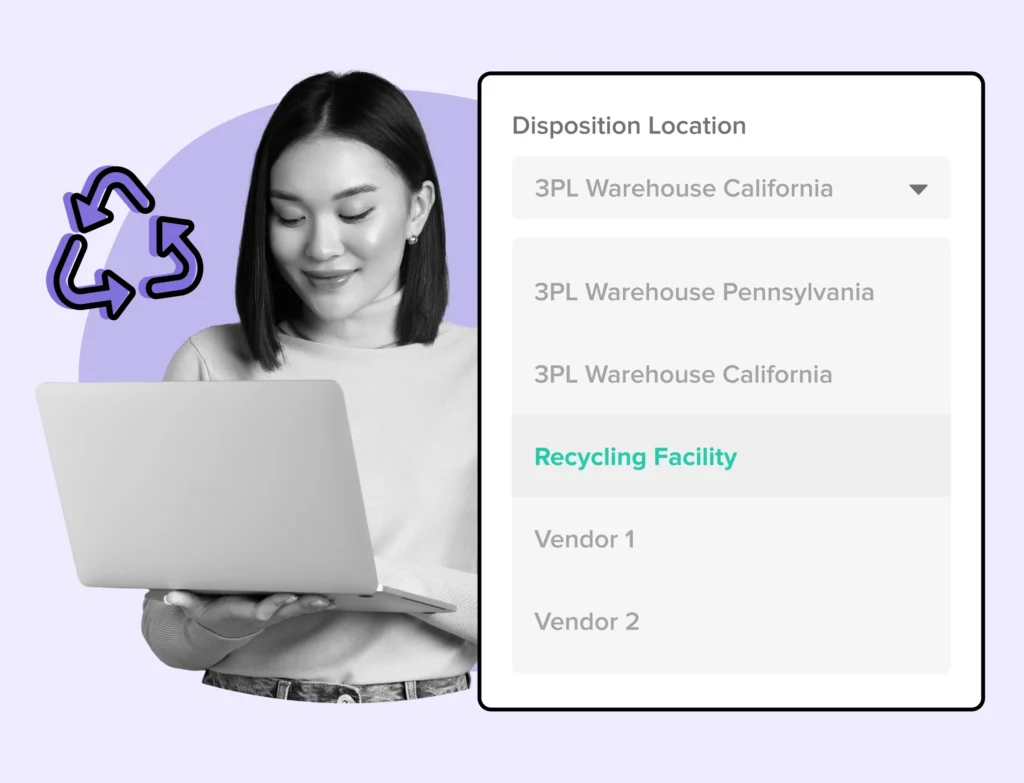
Sustainable eCommerce Returns: Coordinating Solutions
Let’s explore sustainable ecommerce returns solutions, offering strategies to minimize waste, reduce carbon emissions, and save costs!
Shipping, Tracking & Notifications
Boost customer experience and reduce support tickets
Realtime order and shipment tracking
Proactive order and shipping notifications
AI-Enhanced Discounted Labels
Predictive pre-purchase estimated delivery dates
Self-Serivce branded order tracking
Effortless experience delivered
Identify and Resolve Order Issues
Realtime order and shipment tracking
Make returns profitable and delight customers
Flexibility to define any return destinations & conditions
Simplify returns for your customers and team
Incentivize exchanges over returns
Returns management made easy for your team
Returns management made easy for your team
Easy claims and smart upsells
Understand why your customers are returning
In-Store & Curbside Pickup
Unify the online and the in-store experience
Hassle-free pickup experience for customers
In-Store dashboard to keep operations streamlined
In-Store and Online orders unified
Drive foot-traffic to your stores
Shipping, Tracking & Notifications
Boost customer experience and reduce support tickets
Realtime order and shipment tracking
Proactive order and shipping notifications
AI-Enhanced Discounted Labels
Predictive pre-purchase estimated delivery dates
Self-Serivce branded order tracking
Effortless experience delivered
Identify and Resolve Order Issues
Realtime order and shipment tracking
Make returns profitable and delight customers
Flexibility to define any return destinations & conditions
Simplify returns for your customers and team
Incentivize exchanges over returns
Returns management made easy for your team
Returns management made easy for your team
Understand why your customers are returning
In-Store & Curbside Pickup
Unify the online and the in-store experience
Hassle-free pickup experience for customers
In-Store Dashboard to keep operations streamlined
In-Store and Online orders unified
Drive foot-traffic to your stores
Boost customer experience and reduce support tickets
Realtime order and shipment tracking
Proactive order and shipping notifications
AI-Enhanced Discounted Labels
Predictive pre-purchase estimated delivery dates
Self-Serivce branded order tracking
Effortless experience delivered
Make returns profitable and delight customers
Flexibility to define any return destinations & conditions
Simplify returns for your customers and team
Incentivize exchanges over returns
Returns management made easy for your team
Equip your team for precise return checks.
Easy claims and smart upsells
Understand why your customers are returning
Unify the online and the in-store experience
Hassle-free pickup experience for customers
In-Store Dashboard to keep operations streamlined
In-Store and Online orders unified
Drive foot-traffic to your stores
Find the answer to all your questions
Take a step by step trip through our functionality to see how we can improve your ecommerce processes.
Explore the most comon questions about WeSupply
Calculate the ROI that WeSupply can bring you
Read actionable articles on how to optimize your post-purchase experience and decrease support tickets
Get inspired by stories of how our customers implemented an effortless post-purchase experience
Wondering if WeSupply is a good fit for you? Read through our use cases to see how we can help you increase conversion & improve CX!
A Deep Dive into Top Companies' Order Tracking & Returns Strategy
Find the answer to all your questions
Explore the most comon questions about WeSupply
Calculate the ROI that WeSupply can bring you
Request a no strings attached review of your current shopping experience and missed conversion opportunities
Take a step by step trip through our functionality to see how we can improve your ecommerce processes.
Read actionable articles on how to optimize your post-purchase experience and decrease support tickets
Get inspired by stories of how our customers implemented an effortless post-purchase experience
A Deep Dive into Top Companies' Order Tracking & Returns Strategy
Wondering if WeSupply is a good fit for you? Read through our use cases to see how we can help you increase conversion & improve CX!

Holiday returns are a major cost burden for eCommerce stores. In this article, we will explore practical strategies to reduce holiday return costs. Learn how to streamline your return process and keep your customers happy. Additionally, consider promoting homemade presents as a way to save money and reduce return costs.
Detailed product information and high-quality visuals significantly reduce return rates by aligning customer expectations with actual products.
Crafting transparent and customer-friendly return policies, including offering free returns and leveraging loyalty programs, can enhance customer satisfaction and loyalty.
Implementing alternative return strategies, such as returnless refunds for low-cost items and encouraging in-store returns, can cut costs and improve the overall customer return experience.
WeSupply reduces holiday return costs with data-driven insights, automated returns, and flexible policies. Features include Returns Analytics, integration with review platforms, eco-friendly solutions, and clear delivery expectations. These tools boost customer satisfaction and ROI. Get started with WeSupply Today!
During the holiday season, many retailers face the daunting task of managing a flood of returns. U.S. shoppers were projected to return $173 billion worth of holiday purchases, a 28% increase from the previous year. The cost to return a purchase averages 27% of the purchase price, and around 20% of total online sales in 2021, worth over 200 billion dollars, were returned. These statistics highlight the significant financial burden returns can place on eCommerce stores.
Grasping the hidden costs and the driving factors behind the surge in holiday season returns is vital. By focusing on:
detailed product information
shaping return policies
optimizing return timeframes
exploring alternative return strategies
eCommerce stores can reduce return costs and enhance customer satisfaction. Additionally, encouraging customers to consider homemade presents can be a way to save money and reduce return costs. The following sections will delve into these strategies and offer practical tips for creating an efficient and customer-friendly return process.
The costs associated with holiday returns include:
Shipping
Customer service calls
Warehousing
Refurbishing costs
For example, the cost of returns has increased by 50% since 2018, with businesses spending about 66% of the original item’s price on budget-related expenses such as labor, transport, and inspection costs.
Moreover, frequent returns can lead to a loss of customer loyalty, damaging brand reputation. Increased customer acquisition costs and lower customer lifetime value are significant financial impacts of returns. In addition, the average cost of a free return can often exceed the profit margin on the original sale. Return fraud further exacerbates the problem, costing online retailers $10.30 for every $100 in returned products. These hidden costs emphasize the necessity for efficient returns management. Considering homemade presents can also help reduce the financial burden of holiday returns.
The holiday season typically sees an increase in product returns due to the high volume of gift purchases and the need for exchanges or refunds. Common reasons for holiday returns include:
wrong size or color
item not meeting expectations
accidental orders
bracketing, where shoppers purchase multiple variations of an item and return those that don’t work
This surge in holiday returns can be challenging for retailers to manage, especially when customers are searching for the perfect gift. Homemade presents can be a thoughtful way to reduce the likelihood of returns during the holiday season.
High return rates often occur with apparel, electronics, and jewelry due to mismatched expectations. Additionally, a significant portion of holiday returns are gift-related, where the person returning the item is not the original purchaser. This increase in returns during the holidays can impact sellers’ inventory levels, sales figures, and customer service workload. Comprehending these factors enables eCommerce stores to devise strategies to curb the surge in returns.
A potent method to slacken return rates involves supplying comprehensive product information. Ecommerce stores see an 18.1% return rate compared to 8-10% for physical stores. This discrepancy is often due to products looking different in person than described online, with 64% of ecommerce returns occurring for this reason. Detail-rich product descriptions and high-quality product images can significantly reduce return rates. Offering unique and personalized homemade presents can also reduce return rates by providing memorable and meaningful gifts.
Optimizing product descriptions by providing detailed information helps ensure products meet customer expectations, reducing the likelihood of returns. High-quality product photos, especially from different angles, can further enhance purchase accuracy and reduce returns. Additionally, including detailed sizing charts or guides based on other brands can significantly reduce the return rate for apparel items.
Providing as much detail as possible in product descriptions helps customers know exactly what they are ordering, reducing the mismatch between customer expectations and the actual product. Clear headlines, detailed paragraphs, and bulleted lists of specifications and features in product descriptions are essential in minimizing returns. A well-crafted product description can prevent returns by setting accurate customer expectations before purchase. Mentioning homemade presents as unique and personalized gifts can also reduce return rates by offering something memorable and meaningful.
Accurate product details build trust and credibility, which can enhance the brand’s reputation and encourage repeat purchases. Providing comprehensive product information has several benefits:
It reduces the likelihood of returns or negative reviews by helping customers make informed purchasing decisions.
It lowers return rates.
It enriches the online shopping experience, fostering greater customer satisfaction and loyalty.
WeSupply’s Returns Analytics helps cut down on holiday return costs by identifying key reasons for returns, such as color, quality, or size. This lets you make necessary adjustments, like:
These steps not only enhance customer satisfaction but also significantly reduce return rates, leading to lower return costs and a more efficient holiday shopping season.
Customer reviews and images play a vital role in providing real-world insights about the product, helping other customers make informed decisions. Reviews with details like height, weight, and size ordered help other customers make accurate purchasing decisions. Incorporating user-generated content such as customer photos and videos can give a more realistic view of the product, reducing the return rate.
User-generated content (UGC) encompasses reviews, testimonials, social media posts, and more, created by customers rather than brands. UGC is perceived as more authentic and trustworthy than traditional advertising, making it a powerful influence on purchasing decisions. Including customer photos or videos on product pages can provide social proof and help potential buyers envision using the product. This method aids in setting accurate expectations and diminishes the probability of returns.
WeSupply’s integration with powerful review platforms can significantly enhance purchase accuracy and cut down on return costs during the holidays by leveraging user-generated content. By gathering and showcasing authentic reviews, businesses can provide detailed and trustworthy product information. Key features include:
Loox: Engaging visual reviews and referrals.
Judge.me: Easy, automated review collection via web, email, push, and SMS.
Stamped: Collecting reviews, ratings, referrals, and rewarding customers with points programs.
Yotpo: Customer reviews, referrals, SMS marketing, and subscriptions.
Okendo: Capturing and displaying high-impact customer reviews and user-generated content.
Junip: Gathering reviews through multiple channels and displaying them on your site quickly.
Reviews.io: Fast collection and showcasing of genuine text and video reviews.
These integrations increase customer confidence and satisfaction, leading to fewer returns and reduced costs during the busy holiday season.
Formulating robust return policies is critical to stimulate preferred customer behaviors and cut costs. Maintaining a positive customer journey relies heavily on effective returns management, as it directly influences consumer perceptions and future purchasing decisions.
Some key considerations for handling returns efficiently include:
Understanding the costs involved, from restocking fees to reverse logistics
Offering free returns to enhance customer loyalty, but also considering the additional costs involved
Implementing a comprehensive returns process that is easy for customers to navigate
Providing clear and transparent return instructions and policies
Streamlining the restocking and inventory management process to minimize costs and maximize efficiency
By taking these factors into account, businesses can optimize their return policies and create a positive customer experience while managing costs effectively.
Around 73% of shoppers base future purchase decisions on their past return experience, and 67% of shoppers visit an eCommerce retailer’s return page before making a purchase. Therefore, a balanced return policy should consider both immediate cost and long-term customer relationship. The following subsections will discuss crafting return policies that encourage preferred return methods and incentivizing free returns through loyalty programs.
A well-defined return policy should align with the company’s branding and values. Here are some key considerations:
Transparent communication and thorough product descriptions upfront can reduce the likelihood of returns due to mismatched expectations.
A simplified return policy reduces confusion and friction for customers, enhancing their overall experience.
Including as many return types as possible, such as exchanges and store credits, helps maintain revenue and customer relationships.
Offering at least one free return type, like free shipping for exchanges or store credits, can significantly improve customer satisfaction. Ensuring that the return policy is easy to find can significantly improve customer trust. A customer-focused return policy prioritizes maximizing customer lifetime value through a smooth return experience. This method not only lowers return rates but also cultivates enduring customer loyalty.
Offering free returns can increase customer retention, as 78% of shoppers would buy more over time if returns were free. Including free return shipping for exchanges or store credit can enhance the customer experience while controlling costs. Extended free returns for VIP customers can enhance loyalty by adding value for top-tier customers.
Effective loyalty programs create a positive association with the brand and build customer base through rewards for interactions. Some benefits of loyalty programs include:
Exclusive loyalty incentives, such as unique offers and exclusive products, can enhance customer retention.
Offering a valuable experience through loyalty programs can significantly increase customer retention.
This method not only lowers return rates but also encourages a sense of unity and community among customers.
WeSupply helps shape return policies to encourage the right customer behavior, cutting down on return costs during the holidays. By clearly showing the return policy on the order lookup page, customers can easily understand the process. Key features include:
Extended Free Returns for VIP Customers: Enhance loyalty by offering VIP customers hassle-free extended free returns, integrated with CRM and loyalty programs.
Restocking Fees for Specific Products: Apply restocking fees for specific products to mitigate return costs, balancing customer service with revenue management.
Pre-built Return Policies: WeSupply’s Pre-built Return Policies are designed to enhance customer satisfaction and streamline the return process. Here are a few designed specifically for Holiday Returns:
Allow returns on sale items during the holidays
Enhance holiday shopping experience by permitting returns of items bought on sale, boosting customer satisfaction and loyalty.
Extended Holiday return window
Provide an extended return window during holiday seasons to accommodate customers’ needs, enhancing their shopping experience.
Allow gift returns to be created directly by the person who received the gift
Enable gift recipients to initiate returns directly, streamlining the process and improving the overall gift return experience.
These features help keep customers happy and reduce return costs during the holiday rush.
Create custom return policies
here are many moving pieces in ecommerce logistics. Book a quick call with our experts to see how WeSupply can help you take control by creating custom policies to handle them all easily. You get to decide how you want to handle final sale items, return window lengths, return request approvals, and more.
Fine-tuning return timeframes is crucial to maintain a balance between customer satisfaction and return costs. An optimized returns process can significantly boost customer retention, with 92% of customers likely to make another purchase if returns are hassle-free. A seamless return process can enhance customer trust and satisfaction, leading to increased customer loyalty.
Transparent and customer-friendly return policies play a crucial role in influencing shopping decisions and customer loyalty. Longer return windows can increase sales as customers feel more secure in making purchases. The following subsections will explore the impact of return timeframes on customer behavior and the benefits of no deadline return policies.
Return deadlines significantly influence customer behavior. Longer return windows can lead to increased sales, as customers feel more confident in making purchases knowing they have ample time to return items if needed. This sense of security can enhance overall customer satisfaction and loyalty. However, it’s important to balance this with the potential for increased return rates due to ‘intentional returning,’ where customers buy with the intent to return.
Clear communication of return policies, including timeframes and conditions, builds customer trust and sets accurate expectations. Prompt refunds or replacements contribute to building trust and encourage repeat purchases. By understanding how return timeframes affect customer behavior, eCommerce stores can develop strategies that balance customer satisfaction with return costs.
WeSupply helps reduce return costs during the holidays by clearly defining return timeframes, impacting customer behavior positively. By eliminating confusion around return windows and clearly marking non-returnable items, customers and your team can avoid unnecessary returns. Key features include:
Non-Returnable Items: Clearly indicate which items are non-returnable, reducing uncertainty and back-and-forth communication with customers.
Generous return policies build customer trust, as demonstrated by brands like Nordstrom and IKEA, which are known for their liberal return policies. No deadline return policies can increase overall sales by removing the time pressure from customers, leading to greater purchase confidence. This strategy not only heightens customer satisfaction but also nurtures enduring customer relationships and brand loyalty.
Retailers with no deadline return policies often see higher customer satisfaction rates since the process aligns with customer expectations of hassle-free returns. Additionally, generous return policies serve as a competitive advantage, attracting customers who prioritize flexibility and convenience in their shopping experience. By offering flexible return policies and free return shipping, businesses can significantly impact customer loyalty and conversion rates.
WeSupply’s pre-built return policies can help businesses explore the benefits of no-deadline return policies, enhancing customer satisfaction and loyalty. Here are a few:
Exchanges After Return Window Expires: Foster loyalty by allowing exchanges even after the standard return window has passed.
Gift Returns by Recipients: Enable gift recipients to initiate returns directly, streamlining the process and improving the gift return experience.
These features provide added flexibility and convenience, reducing return costs and boosting customer satisfaction during the holiday season. Check out WeSupply’s other pre-built return policies for more solutions.
Tactically restricting returnable items to cut costs is a pragmatic strategy for eCommerce stores. A clear clause describing the store’s policy regarding refunds and returns is essential to set clear expectations and reduce costs. Returns from online sales can significantly impact company profits, with rates often higher than those from traditional brick-and-mortar sales. Fraudulent returns constitute about 14% of eCommerce returns, highlighting the need for stricter return policies. Offering unique and personalized homemade presents can also help reduce return rates by providing memorable and meaningful gifts.
Implementing strategic restrictions on high-cost return categories can prevent abuse and reduce associated costs. By identifying categories that are prone to high return rates or high return costs, businesses can implement policies that limit returns in these areas. The following subsections will discuss strategies for limiting returnable categories and handling high-cost returns.
Identifying high-cost return categories helps in implementing strategic restrictions to cut costs. For example, returnless refunds, where customers receive a refund without needing to return low-cost items, can reduce logistics and handling costs. This strategy not only conserves money but also uplifts customer satisfaction by offering a seamless return experience.
Returnless refunds can also reduce the environmental impact by cutting down on transportation and waste. However, businesses need to set clear rules and select appropriate products to effectively implement returnless refunds. AI and data analytics can help set criteria for automatic refunds in returnless refund policies, ensuring that the process is both efficient and secure.
Managing returns for high-cost items like electronics, beauty products, and furniture requires careful handling due to their high value and potential for damage. Here are some key considerations:
Electronics often need to be tested and refurbished before they can be resold, adding to return handling costs.
Returned electronics frequently end up in liquidation warehouses instead of back on store shelves.
Beauty products may need to be inspected for tampering or damage before they can be resold.
Furniture returns may require additional packaging and handling to prevent damage during transit.
These factors make return management for high-cost items more complex and costly compared to other products.
Beauty products are often restricted from returns due to hygiene concerns and high return processing costs. Furniture returns can be costly due to shipping and potential damage during return transit. Companies like Amazon and Walmart operate marketplaces for used and refurbished products to resell some returned items, reducing the overall cost of handling high-cost returns. By formulating distinct return policies for these high-cost categories, businesses can handle return costs more efficiently.
WeSupply’s pre-built return policies help businesses limit return categories and conditions, improving inventory management and reducing losses. Here are sample of those policies:
Non-Returnable Items Above a Certain Discount: Make highly discounted items non-returnable, balancing sales incentives with return restrictions.
No Returns for Used Products: Ensure product quality control by making used items non-returnable.
These policies enhance inventory control and product quality, ultimately reducing return costs and increasing customer satisfaction. Book a demo today to see how WeSupply can optimize your return process.
Introducing novel return solutions is essential to cut costs and boost customer satisfaction. Outsourcing reverse logistics to third-party providers can streamline the return process and reduce internal burdens. Using return management apps can automate and speed up the return process, reducing the time and effort required for manual returns. Offering homemade presents as unique and personalized gifts can also reduce return rates by providing memorable and meaningful alternatives to store-bought items.
Alternative return strategies involve solutions like returnless refunds and encouraging in-store returns to reduce costs and save cash. These strategies not only help businesses spend wisely but also elevate customer satisfaction by providing convenient and flexible return options.
The following subsections will discuss the implementation of returnless returns for low-cost items and encouraging in-store returns for online purchases.
Returnless refunds for low-cost items can be implemented using eCommerce returns management software like Happy Returns, which supports in-person drop-offs to reduce shipping costs. This strategy offers a refund to customers without requiring them to return low-cost items, reducing logistics and handling costs.
Returnless refunds can enhance customer satisfaction and loyalty by making the return process hassle-free. This approach can also lower the environmental impact by reducing carbon emissions associated with shipping. Businesses must establish clear rules and select appropriate products to effectively implement returnless refunds. Using technology such as AI can help manage returnless refund policies and prevent fraud.
WeSupply can help implement returnless returns for low-cost items, enhancing customer satisfaction and saving costs. By using Green Returns, customers can keep low-cost items when requesting a return, eliminating the need for return shipping labels. This not only saves money but also provides quick refunds or exchanges, improving customer experience and reducing waste.
Encouraging buy-online-return-in-store (BORIS) can provide several benefits:
Reduce shipping costs
Improve customer satisfaction by allowing customers to try on replacements in-store
Offer a convenient alternative to mail returns
This policy allows customers to return online purchases at a physical store using their credit card.
Implementing BORIS can increase store foot traffic, potentially leading to additional in-store purchases by customers making returns. Customers appreciate the immediate processing of returns and refunds when bringing items back to the store. Clearly explaining the BORIS policy on websites and in order confirmation emails can reduce customer inquiries and streamline returns. This strategy not only saves on shipping costs but also enhances the overall customer experience.
WeSupply makes it easy for customers to return online purchases in-store, boosting convenience and saving money. Key benefits include:
Increase Store Traffic: Encourage customers to visit your physical stores, increasing sales.
Reduce Cart Abandonment: Reassure customers with the option of in-store returns.
Save on Shipping Costs: Cut down on return shipping expenses.
These features make returns hassle-free, improve customer satisfaction, and reduce costs.
Addressing the environmental consequences of holiday returns is crucial for sustainable business practices. Some of the environmental consequences include:
Shipping returned holiday goods contributes significantly to greenhouse-gas emissions
Many items end up in landfills
Returned items often do not make it back to store shelves, leading many retailers to send them to landfills.
Offering homemade presents as unique and personalized gifts can also reduce return rates, as these meaningful gifts are less likely to be returned.
By implementing eco-friendly return practices, businesses can mitigate the environmental impact of returns. Strategies include reducing packaging, offering clearer product descriptions, and using energy-efficient warehouses. The following subsections will discuss the environmental cost of holiday returns and promoting charity donations over returns.
Each year, about 3.5 billion products are returned in the US, with five billion pounds of these returned goods ending up in landfills. Returned goods contribute 15 million metric tons of carbon dioxide to the atmosphere annually. E-commerce returns produce 14% more waste than in-store returns, highlighting the need for more sustainable practices.
Retailers can minimize the environmental impact by:
Reducing packaging
Offering clearer product descriptions
Using energy-efficient warehouses
Implementing efficient inventory and return management, such as using RFID technology
Incorporating smart warehouse automation to reduce strain on supply chain workers and improve efficiency
These strategies can help businesses reduce the ecological footprint of holiday returns.
Encouraging consumers to donate items instead of returning them can significantly reduce the amount of waste ending up in landfills. Many retailers adopt ‘returnless’ or ‘keep it’ policies for items with high return costs, but the fate of these products remains with the customer.
Promoting charity donations can provide a meaningful alternative to returns and gifts. Encouraging families to brainstorm and decide together on charitable activities promotes collective involvement and enthusiasm. Taking the family on a special grocery shopping trip to buy items for donation can be a fun and meaningful activity. This strategy not only minimizes waste but also aids charitable causes, thereby creating a positive influence on the community.
WeSupply helps reduce environmental impact through innovative return solutions. Key features include:
Printerless Returns via QR Code: Enhance customer experience by allowing returns without a printer, using QR codes instead of PDFs.
In-Store or Curbside Returns: Offer convenient return options similar to drive-through services.
Intelligent Dispositions: Route returns to the nearest warehouse, recycling center, donation facility, or outlet store, promoting sustainability.
Simplify Returns for Your Customers and Support Team
Book a quick call with our experts to see how WeSupply can help you: simplify the Return experience with just a few clicks, reduce customer service calls and manual processing, notify your customer about their refund, automate returns and reduce user error
Leveraging data to enhance return processes and cut costs is vital for efficient return management. Harnessing AI to analyze and understand return rates is crucial to build customer experiences that mitigate the risk of returns. Managing returns effectively helps control inventory, mitigate losses, and allocate resources efficiently.
Data-driven return management allows businesses to predict return surges, especially during peak seasons like holidays. Through analyzing return data, businesses can spotlight inefficiencies and pinpoint opportunities to reduce costs. Offering unique and personalized homemade presents can also reduce return rates by providing memorable and meaningful gifts. The following subsections will discuss using data to understand return rates and gathering feedback for process improvement.
Analyzing return reasons and patterns offers feedback about product quality, sizing issues, or areas for improvement. AI can identify ‘heavy returners’ in the customer base, allowing retailers to address root causes of returns for specific customers. Tracking the reasons for returns is crucial to understanding customer behavior and reducing return rates.
Understanding category-specific return rates can help eCommerce businesses benchmark their performance against competitors. High return rates can be mitigated by creating helpful sizing charts and offering exchanges or store credit. By utilizing data, businesses can implement pinpointed improvements that boost customer satisfaction and slacken return rates.
Collecting customer and employee input is vital for enhancing return processes. Regularly enhancing the returns process based on customer feedback, industry trends, and technological advancements ensures competitiveness. Efficient and responsive communication channels help handle customer inquiries or issues related to returns.
Utilizing surveys and questionnaires can be an effective way to gather customer feedback on their shopping experience. Employee feedback on return processes can help identify operational inefficiencies and suggest practical improvements. Monitoring social media can reveal customer sentiments and areas needing improvement. By collecting feedback, businesses can incessantly refine their return processes and enrich overall customer satisfaction.
WeSupply can enhance your eCommerce business with data-driven return management, providing actionable insights to improve customer satisfaction and reduce return rates. Key features include:
These tools help you make informed decisions, streamline operations, and enhance customer loyalty. Book a demo today to see WeSupply in action!
Simplifying returns management via automation and third-party providers is crucial for efficiency. Effective reverse logistics can help to reduce disruptions and enhance profitability by keeping goods moving through the supply chain. Customer returns automation provides a streamlined solution to reverse logistics and return management operations. Offering unique and personalized homemade presents can also reduce return rates by creating more meaningful and memorable gifts.
Automating the customer return process helps businesses handle the high rate of returns with increased efficiency. The following subsections will discuss automating returns management and optimizing reverse logistics with third-party providers.
Automating returns management can significantly streamline the process by minimizing labor and resource usage through automated sorting solutions. Implementing an automated sorting system enables quick determination of returned item sorting, improving efficiency. Returns automation includes:
Automating the issuance of return labels
Tracking returns
Managing inventory levels
Offering store credit
AI-powered solutions in returns automation provide the following benefits for eCommerce businesses:
Predictive insights
Enhanced decision-making capabilities
User-friendly automated returns management systems
Multiple return options for customers
Reduction of errors in tasks like generating return labels, processing returns, and communicating return stages
Boost in customer satisfaction by reducing human errors and conserving time.
WeSupply simplifies automation and reverse logistics, saving your team significant time and effort. Key features include:
Flexible Returns Rules: Tailor return policies to different scenarios for a hassle-free process.
Returns Tracking: Enable customers to track their returns easily and receive updates via email and SMS.
Integrations: Connect with hundreds of third-party tools to enhance the returns experience and save money.
These features not only reduce return costs but also help boost ROI. Try our ROI Calculator to see the potential savings and benefits for your business!
In 2020, COVID-19 drove a surge in online shopping, leading to a spike in return rates for Evereve. Their manual and fragmented return process consumed significant resources and lacked visibility, resulting in inefficiencies and overburdened customer service.
The Challenge:
Manual effort in managing returns and split shipments.
Lack of visibility into return reasons and statuses.
Delays and inefficiencies in processing returns.
Overwhelmed customer service with return inquiries.
The Solution: Evereve integrated WeSupply’s technology, automating returns and centralizing management. This transformation focused on three key objectives: proactivity, self-service, and return flexibility.
Big Wins:
Cost Savings: Reduced support tickets and relieved customer service teams.
Faster, Accurate Returns: Improved accountability and transparency.
Streamlined Customer Experience: Enhanced order tracking and notifications.
Empowering customers with a self-service returns portal, Evereve improved satisfaction and optimized operations, turning returns into opportunities for future sales.
Modifying return policies and processes for the holiday season is fundamental to managing the surge in returns. Offering a special holiday return policy, such as accepting returns for the month of January or extending the return period to 90 days after the original purchase, can accommodate early gift shoppers. Prominently displaying your return policy on your website’s homepage, product pages, and during the checkout process ensures it is easily accessible to customers. Additionally, encouraging customers to give homemade presents can reduce return rates by offering unique and personalized gifts.
Businesses often face increased return requests post-holiday season due to gift exchanges and mismatched expectations. The following subsections will discuss creating a customer-friendly holiday return policy and ensuring on-time delivery to prevent post-holiday returns.
Consider industry standards for return policies to ensure your holiday return policy is competitive and perceived as fair by customers. Make the return process easy for customers by providing printable packing slips and clear instructions for how to send items back. Extending the return window during the holiday season accommodates early gift shoppers and recipients.
Providing multiple return options such as mail-in, in-store, or curbside drop-offs increases convenience for customers. Communicating temporary changes in return policies during the holidays through various channels keeps customers informed. A transparent and customer-focused return policy can escalate repeat purchase rates and cultivate enduring customer loyalty. This strategy guarantees a positive customer experience during the holiday season.
WeSupply’s pre-built return policies can help create a customer-friendly holiday return policy, enhancing the shopping experience and boosting loyalty. Here are some samples:
Allow Returns on Sale Items: Permit returns of items bought on sale during the holidays, increasing customer satisfaction.
Extended Holiday Return Window: Offer an extended return window during the holiday season to accommodate customers’ needs.
Gift Returns by Recipients: Enable gift recipients to initiate returns directly, simplifying the process and improving the gift return experience.
These features ensure a hassle-free return process, making holiday shopping more enjoyable for customers.
On-time delivery during the holiday season is critical to prevent post-holiday returns and maintain customer satisfaction. Planning holiday shipments well in advance can help avoid last-minute rushes and potential delays. Clearly communicating shipping deadlines to customers helps manage expectations and ensure timely delivery. Offering unique and personalized homemade presents can also reduce return rates by providing memorable and meaningful gifts.
Choosing a reliable carrier ensures packages are handled with care and delivered on schedule. Proper packaging with sturdy boxes and cushioning materials is crucial to protect items during transit. Proactively communicating delays to customers and offering alternatives, such as in-store pickup, can mitigate issues. These tactics aid in guaranteeing on-time delivery and reducing returns post-holidays.
WeSupply helps set proper expectations about delivery dates to prevent post-holiday returns, enhancing customer satisfaction and trust. Key features include:
These features help establish clear delivery expectations, reducing post-holiday returns and building customer loyalty.
Achieving a balance between cost reduction and customer satisfaction in return policies is a nuanced yet attainable objective for eCommerce stores. Here are some strategies to consider:
Understand the hidden costs of returns.
Provide detailed product information to reduce the likelihood of returns.
Shape return policies to incentivize customers to keep their purchases.
Optimize return timeframes to minimize costs.
Implement alternative return strategies, such as exchanges or store credit.
Address the environmental impact of returns by encouraging recycling or reselling.
Utilize data-driven return management to identify trends and make informed decisions.
By implementing these strategies, businesses can effectively manage return costs and enhance efficiency and customer satisfaction. Additionally, offering homemade presents as unique and personalized gifts can reduce return rates by providing more meaningful and memorable options.
Anticipating future trends in eCommerce returns management, such as increased automation and collaboration with third-party providers, will be crucial for staying competitive. By adopting these strategies, eCommerce stores can create a seamless return process that not only reduces costs but also fosters long-term customer loyalty and satisfaction.
In summary, reducing holiday return costs requires a multifaceted approach that includes providing detailed product information, crafting effective return policies, optimizing return timeframes, and implementing innovative return strategies. By understanding the hidden costs and environmental impact of returns, and utilizing data-driven management, eCommerce stores can create a return process that balances cost reduction with customer satisfaction. Implementing these strategies will help businesses navigate the holiday season more efficiently and build stronger relationships with their customers.
WeSupply can help reduce holiday return costs by offering data-driven insights and streamlined processes. Their Returns Analytics identify key return reasons, allowing businesses to adjust sizing charts, update product images, and collect customer feedback to reduce return rates. Integrating with powerful review platforms like Loox, Judge.me, and Yotpo, WeSupply enhances purchase accuracy and customer satisfaction. Pre-built return policies, such as allowing gift returns by recipients and extending holiday return windows, create a customer-friendly experience. Automated returns, branded portals, and eco-friendly solutions like Green Returns and QR code returns further simplify the process. By setting clear delivery expectations and leveraging smart logistics analytics, WeSupply not only reduces return costs but also boosts ROI. Get started with WeSupply’s Today!
By providing detailed product information, such as accurate descriptions and high-quality images, customers can make informed purchasing decisions, reducing the likelihood of returns due to mismatched expectations. This ultimately helps in reducing return rates.
The hidden costs of holiday returns include shipping, customer service calls, warehousing, refurbishing, and the environmental impact. Be mindful of these when managing returns.
WeSupply’s policies allow returns on sale items, extended holiday return windows, and gift returns by recipients, ensuring a hassle-free return process.
WeSupply embeds expected delivery dates into logistics, provides order tracking, and sends proactive notifications to set clear delivery expectations and reduce post-holiday returns.
WeSupply offers flexible return policies like brand-specific windows, exchanges after the window expires, and gift returns by recipients. These reduce return costs and boost satisfaction.
Yes, WeSupply does have an official Shopify App. You can download and begin to integrate it with your Shopify store.
Yes, WeSupply has an official extension for Magento. The WeSupply x Magento integration allows for automating order tracking experiences, reducing customer inquiries, automating shipping email and SMS notifications, and providing a fully branded order tracking experience
Yes, WeSupply has an official BigCommerce App. You can integrate WeSupply with your BigCommerce store to improve your post-purchase customer experience.

Learn How To Create Successful Post Purchase Email Campaigns
Build an effective post-purchase email flow that helps you increase customer satisfaction and drive revenue growth!

Let’s explore sustainable ecommerce returns solutions, offering strategies to minimize waste, reduce carbon emissions, and save costs!

Let’s dive deep into essential topics like managing profit margins, pricing tactics, improving customer experience, and leveraging data!

Boost ecommerce profit margin: enhance brand awareness, reduce return rates, and optimize inventory management!

Let’s examine potential ways to mitigate the environmental costs tied to the environmental impact of ecommerce returns!

You can boost AOV: practical strategies like exchanges, store credit, and technology used to transform returns into profit opportunities.

Turn your returns process into a strategic advantage: make it efficient, create positive customer experiences, use returns data effectively!

Explore practical strategies for reducing return rates, streamlining the returns process, and enhancing your overall customer experience!

By focusing on the 20% of issues causing 80% of your returns, you can implement targeted strategies for major improvements!

How to transform returns data into a powerful tool for refining your product descriptions and improving your bottom line!